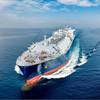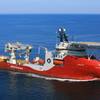New Warming Device Chosen for Crowley Tugs
Crowley Maritime is sending the second of its big new 10,192 hp Prince William Sound class tanker escort tugs, Tan'erliq, north to Alaska this month. It will be following in the wake of the first boat, Nanuq, which went north earlier this year. Both vessels have been designed with cold weather and rough seas in mind, and each features an innovative new deck heating system.
"We were looking for new and innovative technology," said Maynard Willms, vice-president of Vessel Management Services, Inc (VMS), the Crowley subsidiary charged with designing and overseeing construction of the new tugs.
According to Willms, after two years of searching, Crowley settled on a product called STEP warmfloor, a conductive low-voltage plastic invented to prevent accumulations of ice and snow on driveways, sidewalks and floors. For these shore-based applications the plastic was either laid on the ground, with cement poured over it, or it was attached to bare flooring before finishing materials were applied.
For the escort tug application, instead of laying the product down on a surface and putting something over it, VMS elected to tuck it into the insulation affixed to the underside of the deck.
"According to the results of our research on the material," said Willms, "it appears the product will work."
The electrical power requirements to keep the decks ice-free using the STEM warmfloor product were incorporated into the design specifications for the tug's power system. The deck-warming apparatus has its own transformer and distribution system.
"We had to come up with some way to get the power to a central point and then distribute it out to the smaller sections while still keeping the wire size down," said Richard Pollock, electrical engineer for Guido Perla & Associates, the naval architects who worked with VMS on the vessel design.
Since there had been no previous major marine application of STEP warmfloor, VMS and Perla could not rely on the experience of other vessel builders but had to determine the best plan on their own. The decision was to use 283 individual strips of material, all operating at 36 volts. The installed system is approximately 2,250 sq. ft. of actual deck heating area using approximately 36.5 kVA, three phase current.
Until the discovery of STEP warmfloor, Crowley had been using a deck heating system involving a network of pipes through which hot engine coolant water was circulated. However, the piping network required continuous maintenance to control cracks and leaks.
The new plastic low-voltage system is expected to provide the same safety for Crowley's tug personnel in Alaska's near -40 degree F degree winter environment but without the maintenance costs associated with the older warm-water system.
A number of other features have been built into the new Crowley tugs to make them stand out in the Alaskan environment. The deckhouses have been made smaller and streamlined somewhat to reduce windage and icing. The hulls feature heaving belting to enable them to resist ice damage. All machinery spaces are fitted with wing tanks to provide double-side protection, a type of hull configuration aimed at preventing flooding in the worst of ice damage or grounding scenarios.
The vessels also have a high-capacity central heating system to ensure adequate warmth throughout the accommodation during extreme outside temperatures. The forward and aft deck working areas are also heated, and deck fittings have been recessed wherever possible to enable quick snow removal and prevent tripping.
Cranes and exposed deck machinery have been fitted with heating to protect the equipment and to maintain everything in operational order under severe icing. Exposed fire fighting piping has been designed as a "dry" system and fitted with air blow-downs and drains to prevent freeze damage. Exterior ladders are fitted with grip strut open treads for safer footing, and heat strips have been incorporated into the ladders to keep them free of ice and snow.
The engine room, propulsion machinery spaces and storerooms have also been equipped with space heaters for cold weather protection.
On the bridge, Sea Clear electric heated windows have been used, along with a ventilation system that provides heated air flow across the interior of the windows. Wynn heated wipers are used on the window exterior surfaces.
The twin escort vessels also have a high freeboard forward and aft to enhance seakeeping ability and to keep the decks dry, as well as high bulwarks and breakwaters to increase crew protection.
Many of these same cold weather/rough seas features have been specified for three new 140 ft. Prevention and Response Tugs (PRT's) which Crowley is having built by Dakota Creek Industries for operation under long-term contract with the Alyeska Pipeline Service Company.
The three 10,192 hp Z-drive vessels will each have oil spill recovery and storage capability for up to 43,000 gallons of recovered oil and will operate in Valdez Harbor and Prince William Sound - where 300 in. of snow and ice per year is not uncommon.-J.L. Shaw










